Dyrlægens Natmad, or What the Horse Doctor Ate
Dyrlægens natmad is a form of Danish smørrebrød whose name can be translated as something like “Veterinarian’s midnight snack.” Seems that back in the early 20th century, there was a veterinarian called Sigurd Keilgaard–a horse doctor, really, who did work both at the Royal Stables in Copenhagen and for the circus.

Each night, after a long double shift and before he headed home, he’d stop by the wine bar run by Oskar and Petra Davidsen, also known for its wide variety of smørrebrød or open-faced sandwiches. Variety was not what our horse doctor was after, though. Every night, he’d order the same sandwich–rugbrød, or rye bread, smeared with butter or rendered meat fat, liver pâté, salt beef, and aspic. Eventually, they broke down and named the thing after him. In the years since, people have added thin slices of red onion and some garnish of herbs (dill, or parsley, or cress) to the sandwich frequently enough that it’s become canonical, but the basic blueprint remains the same.
Cress
My exploration of dyrlægens natmad has to begin with a callback. This January has seemed like a rerun of January 2015 in general, with both my Egg sandwich post and my Elvis sandwich post referring back to the Breakfast sandwiches and rolls I wrote about last year at this time. The other List sandwich I wrote about last January was the British Rail sandwich, a post in which I repeatedly asked the question “What the hell is cress?” It’s just not something that’s super common in the US.
Back in December, when I told my Danish friend Klavs that I’d be covering dyrlægens natmad soon and had him describe the sandwich to me, he described it as “rye bread with liverwurst, corned beef, and aspic, topped with onion and cress.”
Cress. Again.
Well this time I would be prepared. I ordered some garden cress seeds from Amazon a month ahead of time, and by the time I started working on this sandwich, I had grown a nice crop of cress in the south-facing window of the back room of my house.
Alright, Denmark. I am so ready for you. Let’s make this sandwich.
Rugbrød
Rugbrød is a dark, dense, sour rye bread common in Denmark and Norway. It’s full of seeds and cracked grains and is the base for all Danish smørrebrød open-faced sandwiches.
I wasn’t confident in my ability to reproduce Rugbrød, but as it turned out I didn’t have to. Klavs told me of a Lithuanian bakery in the Chicago area that makes it, but not before I found out that Pleasant House Bakery‘s new artisanal bread bakery is making Rugbrød (among other things) and delivering it fresh to their Bridgeport location on Mondays, Thursdays, and Saturdays. It doesn’t take much arm-twisting to get me to visit Bridgeport, and I was able to secure a loaf on a Saturday morning when they opened.
Sky
Sky is the Danish word for aspic, and aspic is essentially meat jello. You could use the long, slow process of making a homemade stock and reducing it until gelatinous, like this fellow did. You could half-ass it and add unflavored gelatin and bouillon cubes to boiling water like they do on Scandinavia Today.
I took a hybrid approach, using a store-bought stock, flavoring it with onion, parsley, and a bit of soy sauce as in the Scandinavia Today recipe, reducing it a bit and then using unflavored gelatin to finish. It set up quite nicely this way.
Sky, or Danish aspic
Ingredients
- 32 oz chicken stock
- 1 TB soy sauce or Maggi seasoning
- 1 onion chopped
- A handful of parsley leaves
- 4 packets unflavored gelatin
Instructions
- Bring the stock to a simmer with the onion, parsley, and soy sauce.
- Simmer for 25-30 minutes to reduce a bit.
- Add unflavored gelatin. Stir until dissolved. Remove from heat
- Allow to cool on the counter for a bit, then transfer to forms and refrigerate until it solidifies.
Leverpostej
There are a lot of recipes for leverpostej out there. I do not recommend this guy’s approach:
I was going to use this recipe, but when I asked for 3/4lb of pork fat at the butcher shop, I ended up with 1.5lbs. Additionally, the smallest pork liver I could find there was just over 2lbs. So I doubled the recipe and played with the proportions a bit, and wrote up my process a bit more thoroughly. I’m going to go ahead and post the recipe here but again, it’s basically the recipe linked earlier but doubled.
It calls for fatback and onions, run multiple times through the meat grinder, with pork liver added for the final pass. The meats are then mixed with eggs and a nutmeg-and-allspice bechamel before being baked in aluminum forms sitting in a shallow pan of water for 90 minutes. The result is a rich, intensely savory pâté. It could be smoother but I enjoy the rusticity of the texture.
Danish leverpostej
Ingredients
- 2 lbs pork liver
- 1.5 lbs fatback
- 3 red onions chopped
- 6 cloves garlic minced
- 1.5 T kosher salt
- 2 t white pepper
- 1 t allspice
- 1/2 t clove
- 1/2 t fresh grated nutmeg
- 4 T butter
- 4 T all-purpose flour
- 4 cups whole milk hot
- 6 eggs
Instructions
- Mix together the onion, fatback and garlic. Store in freezer until firm but not frozen solid
- Chop up the liver, removing any sinew. Store in freezer until firm but not frozen solid
- Run fatback mixture through large die of meat grinder. Return to freezer until firm but not frozen solid.
- Combine fatback mixture with liver. Run through small die of meat grinder.
- Add eggs, salt, pepper, and spices to liver mixture and combine well.
- Melt butter in pan. Add flour and cook for a few minutes–not enough to add color to the roux, just enough to cook off any floury flavor.
- Add hot milk to roux about 1/2 to 3/4 of a cup at a time, stirring constantly. Make sure each addition of milk is fully and evenly absorbed before continuing.
- Once all milk has been added, cook down, stirring constantly, until the bechamel has thickened a bit. Chill in sealed container.
- Combine bechamel with liver mixture and mix thoroughly.
- Pour into small loaf pans. Bake loaf pans inside a pan shallowly filled with water at 350° F for 90 minutes. Cool before serving.
Saltkød
If you really want a recipe for saltkød, you can check out this overachiever’s site again.
Assembly of the sandwich
Slice the rugbrød fairly thin, as it’s a dense bread and you don’t need too much, but not so thin that it’ll crumple under the hefty pile of toppings we’re going to add.
Butter it. You could use bacon fat or schmaltz or similar instead if you want. Butter’s pretty easy to come by though, and tasty enough for me.
Add the leverpostej. My leverpostej is sliceable, but the texture is so soft and loose that it begs to be spread in a thick layer.
Add a nice thick slice of your salt beef.
Then some of your aspic. You can add a single slice or go for fuller coverage if you want. I just added a couple pieces.
Throw some thin-sliced red onion and herbage on top and voila!
And now, the eating
It’s an interesting combination. Your 2 biggest flavors are the savory liver pâté and the sour, chewy, nutty, grainy bread. The corned beef adds salt and meatiness; the aspic is mouth-filling; the onions and cress are pungent, peppery. There’s a lot going on. And yet… there’s a consistency across the ingredients. Onions come from the root cellar; bread is baked from dried grains year round. Cress will grow pretty much anywhere, anytime. But salt beef, aspic, pâté… these are all forms of meat preservation. These are the flavors of survival.
This is a winter sandwich. These are typical flavors of the Scandinavian diet though. Though the climate is considered temperate, the winters are long and the growing season short. Since the Viking age, their diet has relied largely on foods that have been dried, salted, cured, smoked, pickled, fermented, or kept cool and dry in a root cellar.
Despite all that, it’s really quite good though. The pungent onion and grassy, peppery cress give it the vegetal component it needs to keep it from being too wintery. Just… maybe eat an orange or something too, y’know. You need fresh fruits and vegetables in your diet.
I worry about you, Denmark.
Variants
Den arbejdsløses natmad: “The unemployed midnight snack.” According to this page, it’s a “cheaper” version of the sandwich that uses spegepølse, a Danish hard salami, instead of corned beef, and is topped with chives instead of an herb. I can’t find too many more mentions of it online, though I’ve found other variants that replace the salt beef with sausage or rullepølse, which is sort of a Danish version of porchetta.
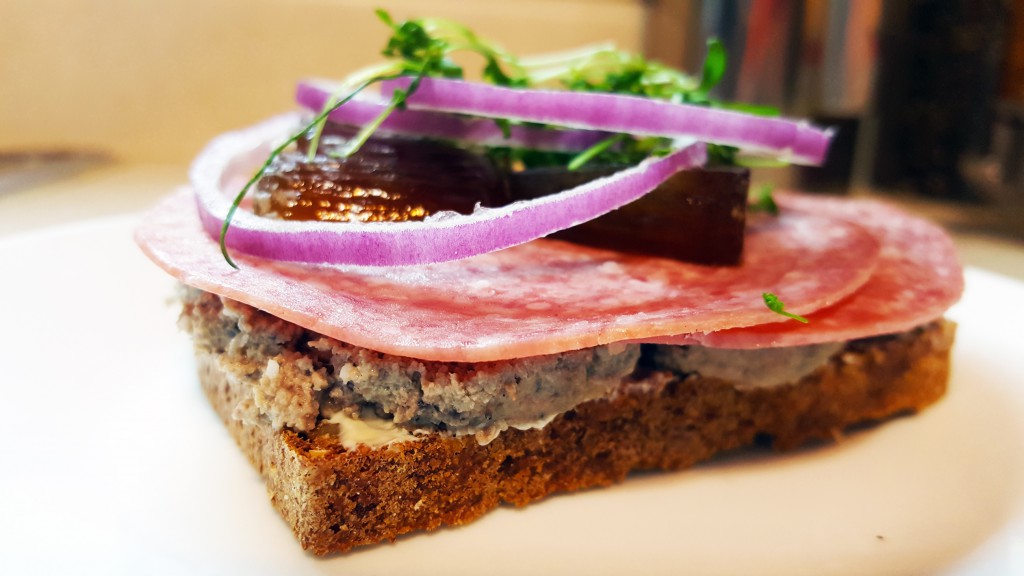
Honestly, I think this might work a little better than the real thing. Salami accentuates the porkiness of the leverpostej, and the funk of fermentation is a good flavor addition here. On first blush, it just seems to work better than salt beef. Mind you, I’m no early 20th century Danish veterinarian though.
Smushi variant: “Smushi” is a recent–less than a decade old–development in Danish cuisine, where traditional smørrebrød are cut and arranged artistically in bite-sized sushi-like portions. Hence the portmanteau: Smushi = smørrebrød + sushi. Yes, the word and concept are both annoyingly cutesy.

Essentially the exact same thing, with minor differences in proportion but with major differences in effort level. This definitely says “gimmicky” to me but there may be more to it than smaller portions and a higher price tag. I doubt it though.
So that’s dyrlægens natmad. It couldn’t be more Scandinavian if you soaked it in lye for a week; it couldn’t be more Nordic if you buried it on a beach and let it rot for 3 months before eating it. Tasty, really tasty, but to be honest, the bread is the best part–I could eat that smeared with butter all day. I look forward to trying it with other combinations when we cover smørrebrød in a few years.

I like sandwiches.
I like a lot of other things too but sandwiches are pretty great



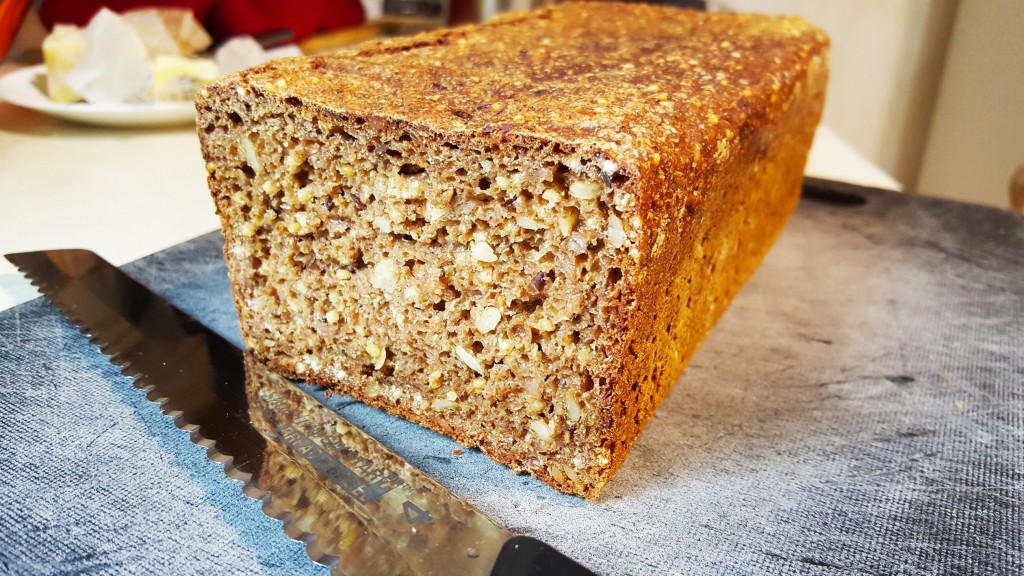




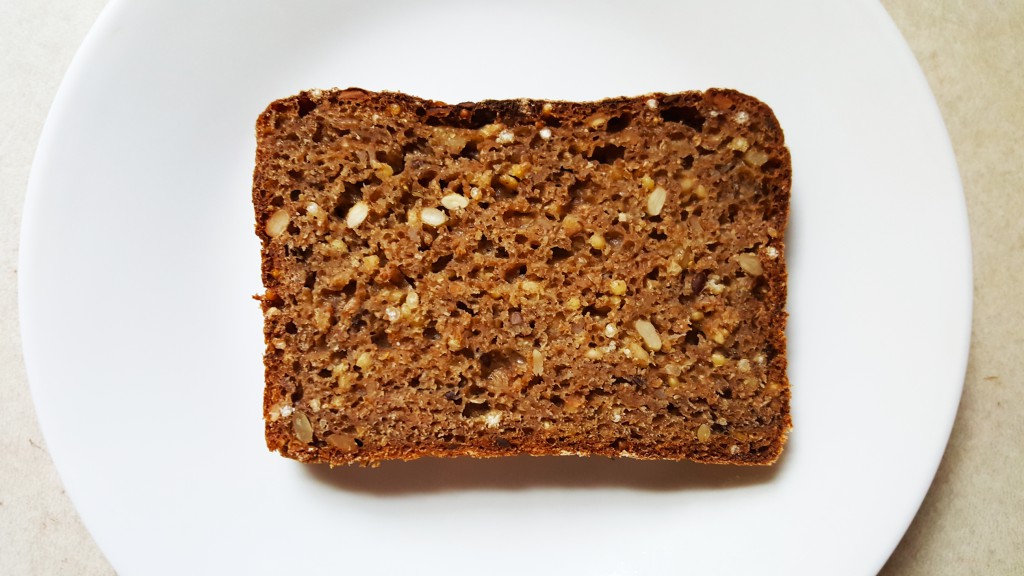
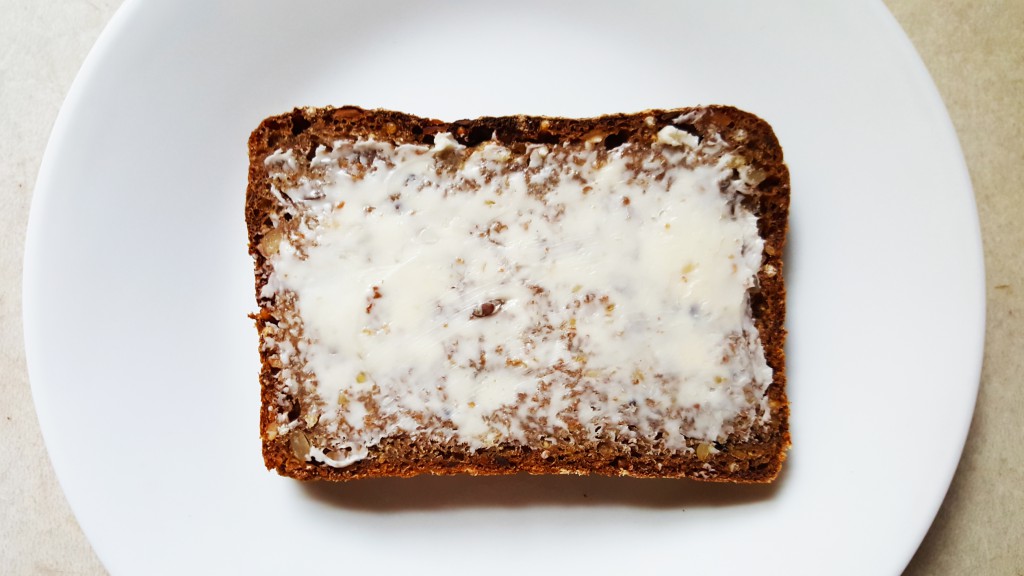
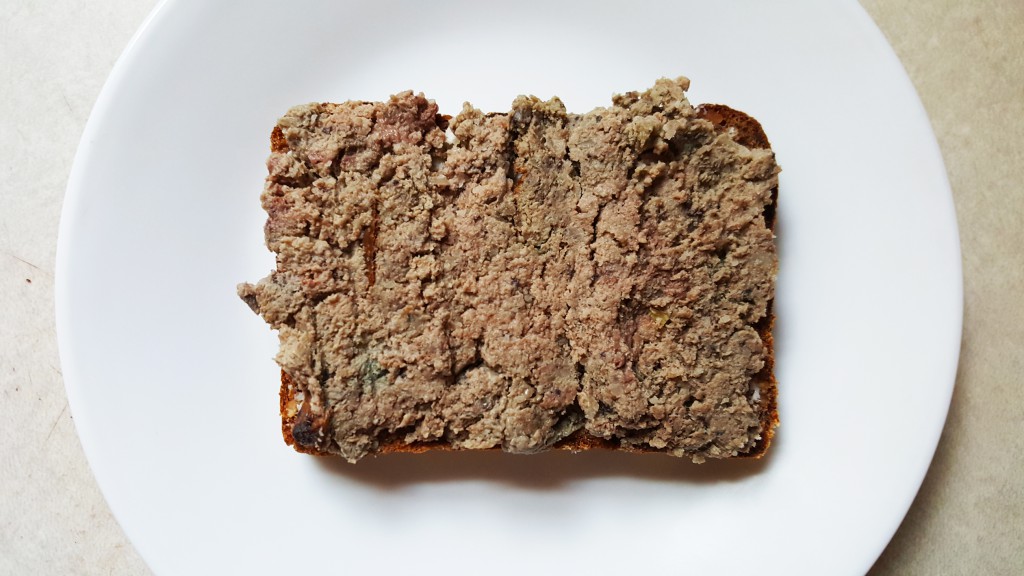



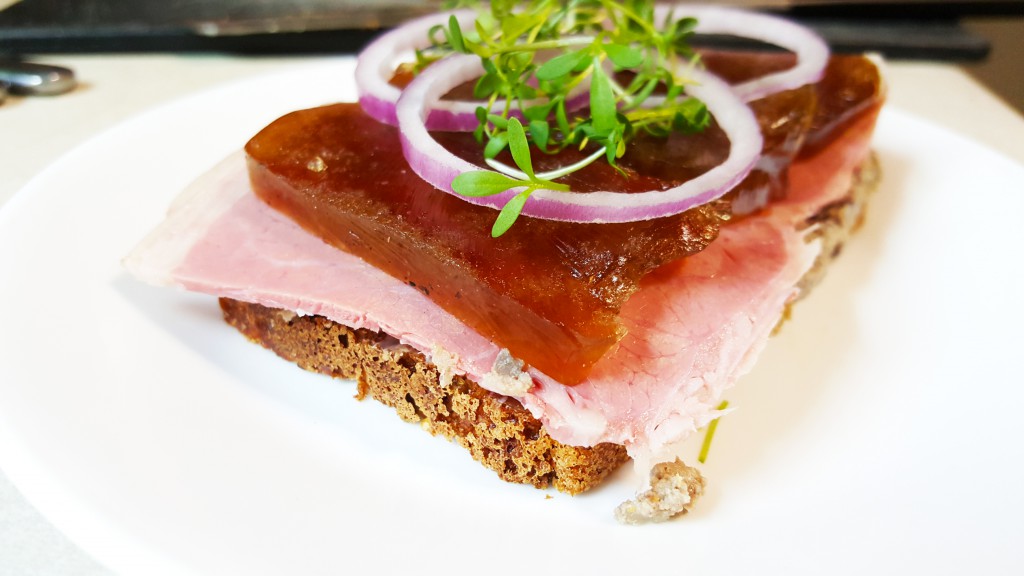



I can’t believe the lengths you will go to. I would have just bought some Oscar Mayer liverwurst. What did you do with all that leverpostej? Actually I have made corned beef from scratch. Not hard.
Haha, I’ve made corned beef from scratch tons of times, including last month. I just didn’t feel like it this time around 🙂
Some of the leverpostej went toward making these sandwiches. Some is being eaten on crackers as a snack. A bunch of it has gone into the freezer until I can think what to do with it.